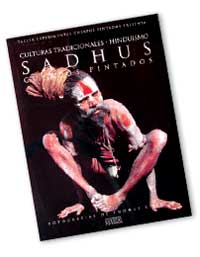 Sadhus are an enigma to me, living the mystery of ancient questions that have no answers. Tricksters, derelicts, madmen, charlatans, wanderers, mystics and yogis, their boldly painted bodies confront us with essential questions at the heart of existence. I found them wandering through crowded polluted urban centres begging, in villages and in what is left of forest and mountain pilgrimage trails. Like walking mysteries of the human soul, for me, sadhus provoke the question, who am I? What do I need, what really is important and the more ancient pre-settled desire to wander in search of god. Most importantly, they remind us that the answer for all things only lies within our own elusive hearts.
Sadhus are an enigma to me, living the mystery of ancient questions that have no answers. Tricksters, derelicts, madmen, charlatans, wanderers, mystics and yogis, their boldly painted bodies confront us with essential questions at the heart of existence. I found them wandering through crowded polluted urban centres begging, in villages and in what is left of forest and mountain pilgrimage trails. Like walking mysteries of the human soul, for me, sadhus provoke the question, who am I? What do I need, what really is important and the more ancient pre-settled desire to wander in search of god. Most importantly, they remind us that the answer for all things only lies within our own elusive hearts. In my adopted home of Kathmandu, some sadhus survive primarily off alms made from allowing tourists to photograph them. They are a spectacle and love to play their assigned role in the illusion or drama of society. Their masks are thickly painted on their naked bodies. Sadhus have formally abandoned conventional time; their world is dense with its own complex politics, social hierarchy, taboos and customs, often making access challenging.
Volatile and unpredictable, spontaneous photography of sadhus can actually be dangerous. You can easily be trampled or attacked if you immerse yourself in a naga baba procession after a mass Khumba Mela bathing. Or, without permission from a Mahant to work inside an Akhara, be accused of being a spy and have to answer to a sadhu tribunal. There's no such thing as achieving photographic acceptance within the sadhu mandala. For me, photographing at ritual time is always the most dynamic and fluid. Once rapport has been established, a camera is tolerated, often with a sense of lila, or maya, play and illusion. It took repeated visits over many seasons and melas to occasionally reach this level.
My initial inexplicable attraction to the sadhu world was mostly visual. As a photographer, I loved how they allowed their bodies to become symbols of the sacred-from walking around naked to remind us of our naked selves, to wearing ash to remind us what are bodies become, to dreadlocks to remind us of our natural wild natures devoid of social convention. Their bodies were texts, which spoke volumes regarding sacred symbolism.
 A sadhu's body is a map of the Hindu universe, for the body is a microcosm of the cosmos. Like a canvas, the colour and painted symbols aid in purification, inspire and remind us of the timeless divine beyond body and form. The body is used to tell stories. As the sadhus work toward an egoless state, they become the very symbols they have painted whether it be Shiva, Vishnu or Ram. The colors refer to esoteric inner visions and possible alchemical states of consciousness. The real goal of a sadhu is to achieve an attitude of non-attachment and transcendence of the physical body.
A sadhu's body is a map of the Hindu universe, for the body is a microcosm of the cosmos. Like a canvas, the colour and painted symbols aid in purification, inspire and remind us of the timeless divine beyond body and form. The body is used to tell stories. As the sadhus work toward an egoless state, they become the very symbols they have painted whether it be Shiva, Vishnu or Ram. The colors refer to esoteric inner visions and possible alchemical states of consciousness. The real goal of a sadhu is to achieve an attitude of non-attachment and transcendence of the physical body. As a photographer, I sometimes like to hide behind my lens, become invisible. Yet for sadhus, it is their very outlandish visibility, the powerful symbols of the divine they paint on their bodies, which help them not to become invisible, but to transcend self. Disturbing, annoying, inspiring, exasperating, irrational, wise and powerful, photographing sadhus is like photographing a living question that people have forgotten to ask. l
Thomas L Kelly first came to Nepal in 1978 as a Peace Corps Volunteer and has since worked as a photo-activist, documenting the struggles of marginalised people and disappearing cultural traditions all over the world. He has researched and photographed the books: Fallen Angels: Sex Workers of South Asia, Tibet: Reflections from the Wheel of Life; The Hidden Himalayas; Kathmandu: City on the Edge of the World.
 The book, Sadhus Cuerpos Pintados by Thomas Kelly has just been published by Taller Experimental Querpos Pintados LTD, Santiago, Chile. Kelly's colour prints from the book will be on display at Indigo Gallery at an exhibition titled 'Sadhus: The Great Renouncers' from 13-29 February. A group of Ram Bhakti Sadhus will be playing bhajans from 5:00-6:30 PM on 13 February at Indigo Galley.
The book, Sadhus Cuerpos Pintados by Thomas Kelly has just been published by Taller Experimental Querpos Pintados LTD, Santiago, Chile. Kelly's colour prints from the book will be on display at Indigo Gallery at an exhibition titled 'Sadhus: The Great Renouncers' from 13-29 February. A group of Ram Bhakti Sadhus will be playing bhajans from 5:00-6:30 PM on 13 February at Indigo Galley. 

